Visualization of Gas Transfer at Air-Sea Interface by PIV-LIF Method Nobuhito Mori
advertisement
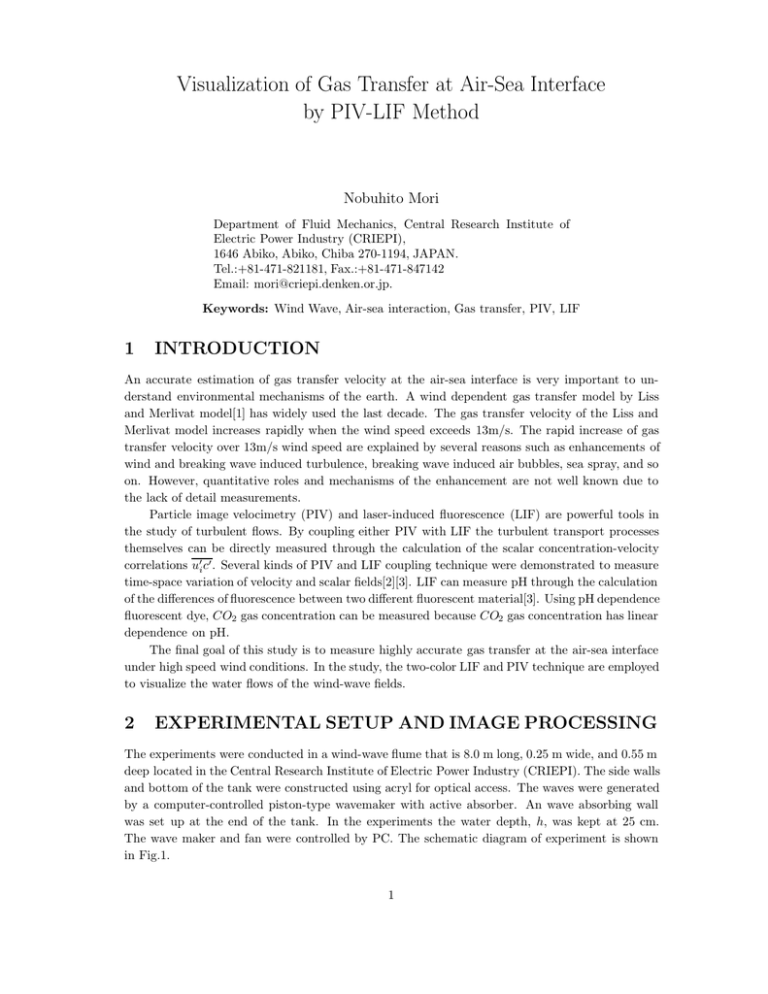
Visualization of Gas Transfer at Air-Sea Interface by PIV-LIF Method Nobuhito Mori Department of Fluid Mechanics, Central Research Institute of Electric Power Industry (CRIEPI), 1646 Abiko, Abiko, Chiba 270-1194, JAPAN. Tel.:+81-471-821181, Fax.:+81-471-847142 Email: mori@criepi.denken.or.jp. Keywords: Wind Wave, Air-sea interaction, Gas transfer, PIV, LIF 1 INTRODUCTION An accurate estimation of gas transfer velocity at the air-sea interface is very important to understand environmental mechanisms of the earth. A wind dependent gas transfer model by Liss and Merlivat model[1] has widely used the last decade. The gas transfer velocity of the Liss and Merlivat model increases rapidly when the wind speed exceeds 13m/s. The rapid increase of gas transfer velocity over 13m/s wind speed are explained by several reasons such as enhancements of wind and breaking wave induced turbulence, breaking wave induced air bubbles, sea spray, and so on. However, quantitative roles and mechanisms of the enhancement are not well known due to the lack of detail measurements. Particle image velocimetry (PIV) and laser-induced fluorescence (LIF) are powerful tools in the study of turbulent flows. By coupling either PIV with LIF the turbulent transport processes themselves can be directly measured through the calculation of the scalar concentration-velocity correlations ui c . Several kinds of PIV and LIF coupling technique were demonstrated to measure time-space variation of velocity and scalar fields[2][3]. LIF can measure pH through the calculation of the differences of fluorescence between two different fluorescent material[3]. Using pH dependence fluorescent dye, CO2 gas concentration can be measured because CO2 gas concentration has linear dependence on pH. The final goal of this study is to measure highly accurate gas transfer at the air-sea interface under high speed wind conditions. In the study, the two-color LIF and PIV technique are employed to visualize the water flows of the wind-wave fields. 2 EXPERIMENTAL SETUP AND IMAGE PROCESSING The experiments were conducted in a wind-wave flume that is 8.0 m long, 0.25 m wide, and 0.55 m deep located in the Central Research Institute of Electric Power Industry (CRIEPI). The side walls and bottom of the tank were constructed using acryl for optical access. The waves were generated by a computer-controlled piston-type wavemaker with active absorber. An wave absorbing wall was set up at the end of the tank. In the experiments the water depth, h, was kept at 25 cm. The wave maker and fan were controlled by PC. The schematic diagram of experiment is shown in Fig.1. 1 Wave generator FAN 8.0m Main Control PC Figure 1: Experimental setup CCD Cameras Frame Grabber Air Water Cylindrical Lens Pulse Controller YaG Laser Main Control PC Figure 2: Schematic view of measurement The free surface elevation was measured using five capacitance-type wave gage and digital images. Double pulse Nd:YaG laser with a wavelength of 532 nm was used as the light source. A cylindrical lens mounted in front of the laser was used to create the light sheet. Three 10-bit CCD cameras (RedLake ES1.0) with a resolution of 1K×1K pixels were used to capture the images. The images were captured in a duration of 10s at a framing rate of 15 frames per second for LIF and 30 frames per second for PIV. Two CCD cameras were used for LIF and one CCD camera was used for PIV. Each captured images was directly stored in individual PCs. The schematic illustration of the cameras and control unit is shown in Fig.2. Main control PC controlled the wind fan rpm and amplitude and frequency of the wave generator. In order to understand the relationship between the flow pattern of the free surface elevation, all the data was taken simultaneously and synchronized by main control computer. The 2 base pulse was generated by pulse control PC at a rate of 15 per second. The emission of light of YaG laser was triggered by base pulse. The duration of sequential pulses was 200µs. The schematic diagram of pulses is shown in Fig.3. The fluorescent sodium dye (FNa) and WT were used to visualize on the vertical plane of the wind-wave flume. The fluorescence of fluorescein sodium is strongly pH sensitive at pH ¡ 7 and its temperature dependence is weak. On the other hand, the fluorescence of WT is independent from pH. The measured fluorescence of fluorescein sodium and WT in the experiments are shown Fig.4. The WT is independent from pH, although fluorescein sodium is linearly dependent at pH¡7. For PIV, 50µm polyethylene particles were mixed in the tank. 1.5 Base Trigger from Pulse Control PC 5V 1.125 CCD Exposure for LIF I/I pH=7 0V FNa WT CCD Exposure for PIV 0.75 0.375 YaG Laser 0 2 4 T1 6 8 10 pH T2 Exposure Time Figure 4: Relationship between pH and fluorescein intensity of FNa and WT ∆t Figure 3: Diagram of pulse, CCD exposure and laser emission 3 RESULTS AND DISCUSSIONS LIF traditionally relies on a linear relationship between local fluorescence intensity F and local dye concentration C. A simple model for this process is F (x, y, t) = αA(x, y) I(x, y, t) C(x, y, t) (1) where α is fluorescent efficiency, A is the spatially dependent optical transfer function of the system, I is the local light intensity. α and A(x, y) can be assumed as constant in the field. Thus, local pH can be measured by FF N a [I(x, y, t) C(x, y, t)] F N a = (2) FW T [I(x, y, t) C(x, y, t)] W T If FF N a /FW T is known as a function of pH or CO 2 concentration, simultaneous pH or CO2 concentration can be measured. The uncertainty due to image distortion was also checked using fixed markers in the tank and found that the maximum error was 1.5 mm (about 5 pixels). The free surface profile was determined from the images by using the edge detection technique. The edge detection error is 2 pixels maximumly. Therefore, the error in measuring the free surface elevation is within 3 mm. Fig.5 shows typical instantaneous velocity field superimposed on the simultaneously captured normalized pH concentration for the case of wind speed u∗ =0.5m/s. The size of image is 200 mm 3 Figure 5: Typical instantaneous velocity field superimposed over pH concentration (size of image is 200X200mm). × 200 mm. The top edge of figure indicates free surface, The downward bursting from the free surface induce highly concentrated gas into deep water. 4 CONCLUSIONS A PIV-LIF experiments was conducted to measure the CO2 gas transfer at air-water interface under in the wind-wave flume. The experimental result shows instantaneous gas concentration and velocity field, quantitatively. The detail of results of experiments will be discussed at the conference. References [1]P. Liss and L. Merlivat. Air-sea gas exchange: introduction and synthesis. he role of air-sea exchange in geochemical cycling, pages 113–127, 1986. [2]K. Hishida and J. Sakakibara. Combined plif-piv technique for velocity/scalar fields. Proceedings of the third international workshop on PIV’99, 1:21–24, 1999. [3]E.A. Cowen, K.-A. Chang, and Q. Liao. A single camera coupled ptv-lif technique. Experiments in Fluids, 31:63–73, 2001. 4
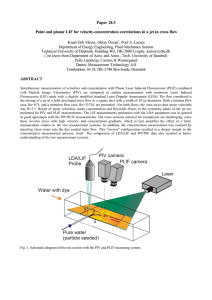
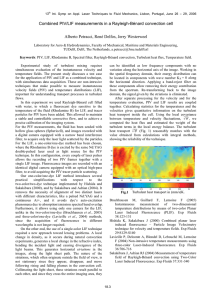

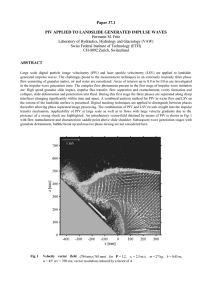
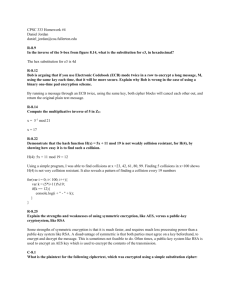

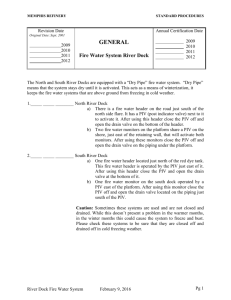
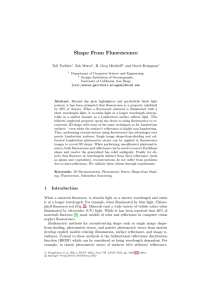
![This article was downloaded by: [Canadian Research Knowledge Network] On: 8 September 2008](http://s2.studylib.net/store/data/012070943_1-102c34e52d5db4d6b03a7db0b70d40b9-300x300.png)